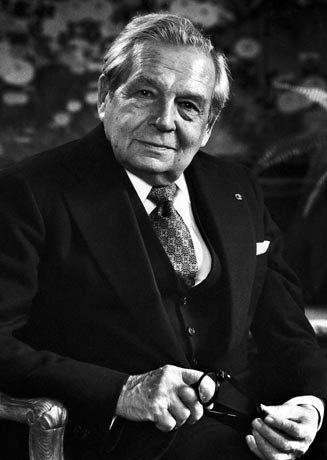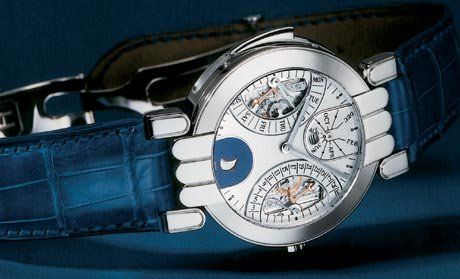
SJX
[Purist]
8540

The Tale of Two Brothers - How Harry Winston became "HWD" on the New York Stock Exchange
The Tale of Two Brothers
By Su JiaXian
A good number of the most expensive gems in history once passed through the hands of Harry Winston. Known as the “King of Diamonds”, Harry Winston himself was a legend; Marilyn Monroe sang about him in “Diamonds are a Girl’s Best Friend”. His eponymous firm has outfitted movie stars for the red carpet at the Oscars for decades. In 1993 the company famously went to court to retrieve a necklace it worn by Sharon Stone. She had been under the impression that the $400,000 piece of jewellery was a gift to her. Despite all that glamour and fame, Harry Winston himself was intensely private - the only photo of him ever released was with his obituary in 1978.

The 1978 photo of Harry Winston
The legend began in 1908 when the twelve-year-old Winston spotted a ring with dull green stone in a pawnshop and promptly bought it for twenty-five cents. Winston’s father, Jacob, a New York jeweller himself, was stunned when he saw the ring – it was a two carat emerald – which Harry later sold it for $800. Thus began the career of one of the great jewellers of the 20th century.
In 1920, at the age of 24, Winston started his first business, the Premier Diamond Company, located at 535 Fifth Avenue, New York. He soon began buying entire jewellery collections, including that of Arabella Huntington, wife of railroad tycoon Collis P. Huntington. Winston purchased only the best and in 1930 he bought a 39-carat diamond, at the time the largest such gem sold in the United States. By the end of his career, Winston had owned, at one time or another, most of the history’s famous diamonds, including the infamous Hope Diamond. And when Winston decided to donate the cursed million-dollar stone to the Smithsonian in 1958, he famously sent it via USPS.
After Winston passed away in 1978, his elder son, Ronald, assumed control of Harry Winston. Ronald Winston, a Harvard educated chemist, ran the company much like his father did, as a purveyor of ultra-expensive serving the wealthy, and not the rich. Legend has it that a staff member at the New York Harry Winston store once advised a customer who was looking to spend $35,000 to go Tiffany’s instead. Unlike rivals like Cartier and Bvlgari, the House of Winston continued to operate as a jeweller, rather than a luxury goods company, although it did diversify into luxury watches.
Harry Winston unveiled its first watch in 1989, a bi-retrograde perpetual calendar in platinum. Unusually for a jeweller, especially during that era, the watch was a technical achievement, being the first retrograde perpetual calendar. The movement was designed by Roger Dubuis and Jean-Marc Wiederrecht, who eventually went on to become noted watchmakers.

Harry Winston Bi-Retrograde Perpetual Calendar, c. 1989
Harry Winston Rare Timepieces (HWRT) remained a low-key player in the timepiece segment, making only several hundred watches a year, until the revolutionary Opus series of watches was unveiled. The brainchild of then CEO Maximilian Busser, the Opus series was a stroke of brilliance that catapulted Harry Winston into the watchmaking stratosphere. Each Opus a collaborative effort between HWRT and an independent watchmaker; the list of Opus watchmakers reads like a Who’s Who of contemporary watchmaking - Journe, Halter, Claret, Baumgarter are just some of those who have worked on an Opus. Not only did the Opus series put HWRT on the map, it undeniably encouraged the careers of those watchmakers as well as sparked a wider interest in independent watchmaking.
Yet as the Opus watches were taking the horological world by storm, Harry Winston was in turmoil, a result of an ugly fight between Ronald and Bruce Winston over the company. That decade-long fight eventually culminated in the listing of Harry Winston Diamond Corp. on the NYSE in November 2007 - the final chapter in the acrimonious battle between Ronald and Bruce Winston.
From the time they were young, the Winston brothers were as different as gold and platinum. By most accounts Ronald was the more successful brother; after graduating from Harvard, Ronald studied rocket propulsion at NYU, before joining Harry Winston. Since divorced, Ronald is a keen student of Japanese culture - he speaks Japanese and reads Zen philosophy.
Ronald’s personality and achievements stood in stark contrast to those of his brother. Twice married, Bruce Winston dropped out of university, and as a teenager, once disappeared for several weeks leading his family to call the police. Unlike Ronald, the Zen devotee who is a self-described workaholic, Bruce sails and collects sports cars.
When their father passed away in 1978, he left the running of the company to Ronald and two trustees, but instructed that both brothers should get equal income from the company. That worked well enough, each brother received about $350,000 annually, with Bruce completely uninvolved with the business. But from 1980 onwards Ronald began increasing his own salary until it topped $1 million in 1990, which he justified by contending he operated the company thus deserved more compensation.
Things then began to unravel in 1990 when Bruce filed a suit against Ronald demanding more information about the finances of the company, followed by another two years later which alleged financial misconduct. Ronald made several offers to buy his brother out but Bruce refused, adamant that those offers undervalued the company.
Needless to say, the company did not prosper as the brothers slugged it out in court. With no end in sight to the legal battle, a Westchester County judge ordered the company to be sold in 1998.
Both brothers finally settled in 2000 when Bruce sold his stake in Harry Winston Inc. for $44 million. Funds for that payment came from Fenway Partners, a New York-based private equity group, which received a 55% stake in return. The rest of the company remained with Ronald, but not for long.
Three years later, Fenway Partners wanted to cash out and Aber Diamond Corp. of Canada announced its plans for a friendly takeover of Harry Winston. By May 2004, Aber had acquired a 51% stake in Harry Winston for $85 million with an option to buy the rest of the company. Thomas O’Neill, a former president of Burberry, the British fashion label, was recruited to become CEO. Ronald Winston said at the time of the takeover, “This is a great day in the 70 year history of Harry Winston… It fulfills my father's dream of creating a company that extends from the mine to the finished jewel.”

Ronald Winston
Aber soon exercised its option and in September 2006, for an additional $157 million, it bought the rest of Harry Winston. A year later, Aber took on the glorious name of Harry Winston and the company began trading on the NYSE under the ticker symbol “HWD”. Today it is near impossible to find any mention of Ronald Winston on the latest company literature.
Unsurprisingly, Harry Winston has since embarked on international expansion. It now has 18 boutiques worldwide and plans to grow. Shoppers who want to spend $35,000 - or even less - will surely find something in a Harry Winston boutique. Cartier, once the ‘king of jewellers and jeweller to kings’, is now a multi-billion franc businesses by becoming, heavens no, not cheap, but accessible.
Going back to the Opus series and HWRT; earlier this year the Opus 8 was unveiled to a vigorous reception, some see the Opus 8 as a poor imitation of its predecessors. A noted observer and fan of HWRT commented that the watch brand “is now being run ‘American style’ after Max left. This means taking away the faces of the execs, and replacing it with a corporate logo.” He continued, “Even Patek uses the face of Stern, and so does VC, AP, RM; only Cartier and Bulgari are faceless - but is that HWRT's strength?”
Harry Winston will one day sit next to Cartier and Bvlgari at airport duty-free shopping, which is surely the definitive sign of commercial success. Ronald and Bruce Winston have both received handsome amounts for their stakes in the company - imagine the Zen gardens and sailboats all that money can buy. But if Ms Monroe were alive, would she still sing about Harry Winston?
References:
Adler, Claire (11 Nov 2005). Celebrity endorsement: Vote of confidence money can't buy. Financial Times.
Burleigh, Nina (Jan 1999). The Trouble with Harry Winston. New York Magazine.
Steinhauer, Jennifer (21 May 1998). Feud Puts Harry Winston's Glitters Up for Sale. The New York Times.
Thomson, Michael (1 Dec 2003). Aber to Buy Harry Winston. Professional Jeweler Magazine.
--- (May 2004). Aber Completes Purchase Of Harry Winston. The Diamond Registry.
--- (2 Apr 2004). Aber Diamond Corporation completes purchase of majority interest in Harry Winston Inc. Harry Winston Diamond Corporation (press release).
This message has been edited by SJX on 2008-05-25 08:50:14

The Tale of Two Brothers - How Harry Winston became "HWD" on the New York Stock Exchange

A good read - I cannot remember the story of Kane and Abel too

As another poster mentioned above





